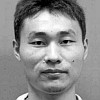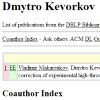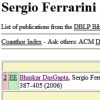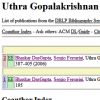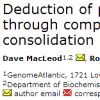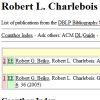| |
  
Ali Tofigh,
Mike Hallett and
Jens Lagergren. Simultaneous Identification of Duplications and Lateral Gene Transfers. In TCBB, Vol. 8(2):517-535, 2011.
Keywords: duplication, explicit network, FPT, from rooted trees, from species tree, lateral gene transfer, loss, NP complete, phylogenetic network, phylogeny, reconstruction.
Note: http://dx.doi.org/10.1109/TCBB.2010.14.
Toggle abstract
"The incongruency between a gene tree and a corresponding species tree can be attributed to evolutionary events such as gene duplication and gene loss. This paper describes a combinatorial model where so-called DTL-scenarios are used to explain the differences between a gene tree and a corresponding species tree taking into account gene duplications, gene losses, and lateral gene transfers (also known as horizontal gene transfers). The reasonable biological constraint that a lateral gene transfer may only occur between contemporary species leads to the notion of acyclic DTL-scenarios. Parsimony methods are introduced by defining appropriate optimization problems. We show that finding most parsimonious acyclic DTL-scenarios is NP-hard. However, by dropping the condition of acyclicity, the problem becomes tractable, and we provide a dynamic programming algorithm as well as a fixed-parameter tractable algorithm for finding most parsimonious DTL-scenarios. © 2011 IEEE."
|
|
| |
    
Jean-Philippe Doyon,
Celine Scornavacca,
Konstantin Yu Gorbunov,
Gergely J. Szöllösi,
Vincent Ranwez and
Vincent Berry. An efficient algorithm for gene/species trees parsimonious reconciliation with losses, duplications, and transfers. In Proceedings of the Eighth RECOMB Comparative Genomics Satellite Workshop (RECOMB-CG'10), Vol. 6398:93-108 of LNCS, springer, 2011.
Keywords: branch length, duplication, dynamic programming, explicit network, from multilabeled tree, from species tree, from unrooted trees, lateral gene transfer, loss, phylogenetic network, phylogeny, polynomial, Program Mowgli, reconstruction.
Note: http://www.lirmm.fr/~vberry/Publis/MPR-DoyonEtAl.pdf, software available at http://www.atgc-montpellier.fr/MPR/.
Toggle abstract
"Tree reconciliation methods aim at estimating the evolutionary events that cause discrepancy between gene trees and species trees. We provide a discrete computational model that considers duplications, transfers and losses of genes. The model yields a fast and exact algorithm to infer time consistent and most parsimonious reconciliations. Then we study the conditions under which parsimony is able to accurately infer such events. Overall, it performs well even under realistic rates, transfers being in general less accurately recovered than duplications. An implementation is freely available at http://www.atgc- montpellier.fr/MPR. © 2010 Springer-Verlag."
|
|
| |
  
Mukul S. Bansal,
J. Peter Gogarten and
Ron Shamir. Detecting Highways of Horizontal Gene Transfer. In Proceedings of the Eighth RECOMB Comparative Genomics Satellite Workshop (RECOMB-CG'10), Vol. 6398:109-120 of LNCS, springer, 2011.
Keywords: explicit network, from rooted trees, from species tree, lateral gene transfer, phylogenetic network, phylogeny, polynomial, reconstruction.
Note: http://www.cs.iastate.edu/~bansal/Highways_RCG10.pdf.
Toggle abstract
"In a horizontal gene transfer (HGT) event a gene is transferred between two species that do not share an ancestor-descendant relationship. Typically, no more than a few genes are horizontally transferred between any two species. However, several studies identified pairs of species between which many different genes were horizontally transferred. Such a pair is said to be linked by a highway of gene sharing. We present a method for inferring such highways. Our method is based on the fact that the evolutionary histories of horizontally transferred genes disagree with the corresponding species phylogeny. Specifically, given a set of gene trees and a trusted rooted species tree, each gene tree is first decomposed into its constituent quartet trees and the quartets that are inconsistent with the species tree are identified. Our method finds a pair of species such that a highway between them explains the largest (normalized) fraction of inconsistent quartets. For a problem on n species, our method requires O(n 4) time, which is optimal with respect to the quartets input size. An application of our method to a dataset of 1128 genes from 11 cyanobacterial species, as well as to simulated datasets, illustrates the efficacy of our method. © 2010 Springer-Verlag."
|
|
| |
 
Marc Thuillard and
Vincent Moulton. Identifying and reconstructing lateral transfers from distance matrices by combining the Minimum Contradiction Method and Neighbor-Net. In JBCB, Vol. 9(4):453-470, 2011.
Keywords: from distances, lateral gene transfer, minimum contradiction, NeighborNet, phylogenetic network, phylogeny, reconstruction.
Note: http://dx.doi.org/10.1142/S0219720011005409, slides available at http://www.newton.ac.uk/programmes/PLG/seminars/062015501.html.
Toggle abstract
"Identifying lateral gene transfers is an important problem in evolutionary biology. Under a simple model of evolution, the expected values of an evolutionary distance matrix describing a phylogenetic tree fulfill the so-called Kalmanson inequalities. The Minimum Contradiction method for identifying lateral gene transfers exploits the fact that lateral transfers may generate large deviations from the Kalmanson inequalities. Here a new approach is presented to deal with such cases that combines the Neighbor-Net algorithm for computing phylogenetic networks with the Minimum Contradiction method. A subset of taxa, prescribed using Neighbor-Net, is obtained by measuring how closely the Kalmanson inequalities are fulfilled by each taxon. A criterion is then used to identify the taxa, possibly involved in a lateral transfer between nonconsecutive taxa. We illustrate the utility of the new approach by applying it to a distance matrix for Archaea, Bacteria, and Eukaryota. © 2011 Imperial College Press."
|
|
| |
 
Gergely J. Szöllösi and
Vincent Daubin. Modeling Gene Family Evolution and Reconciling Phylogenetic Discord. In Evolutionary Genomics, Statistical and Computational Methods, Volume 2, Methods in Molecular Biology, Vol. 856:29-51, Chapter 2, springer, 2011.
Keywords: duplication, from multilabeled tree, lateral gene transfer, likelihood, phylogeny, reconstruction, statistical model.
Note: ArXiv version entitled The pattern and process of gene family evolution.
Toggle abstract
"Large-scale databases are available that contain homologous gene families constructed from hundreds of complete genome sequences from across the three domains of life. Here, we discuss the approaches of increasing complexity aimed at extracting information on the pattern and process of gene family evolution from such datasets. In particular, we consider the models that invoke processes of gene birth (duplication and transfer) and death (loss) to explain the evolution of gene families. First, we review birth-and-death models of family size evolution and their implications in light of the universal features of family size distribution observed across different species and the three domains of life. Subsequently, we proceed to recent developments on models capable of more completely considering information in the sequences of homologous gene families through the probabilistic reconciliation of the phylogenetic histories of individual genes with the phylogenetic history of the genomes in which they have resided. To illustrate the methods and results presented, we use data from the HOGENOM database, demonstrating that the distribution of homologous gene family sizes in the genomes of the eukaryota, archaea, and bacteria exhibits remarkably similar shapes. We show that these distributions are best described by models of gene family size evolution, where for individual genes the death (loss) rate is larger than the birth (duplication and transfer) rate but new families are continually supplied to the genome by a process of origination. Finally, we use probabilistic reconciliation methods to take into consideration additional information from gene phylogenies, and find that, for prokaryotes, the majority of birth events are the result of transfer. © 2012 Springer Science+Business Media, LLC."
|
|
| |
   
Mukul S. Bansal,
Guy Banay,
J. Peter Gogarten and
Ron Shamir. Detecting Highways of Horizontal Gene Transfer. In JCB, Vol. 18(9):1087-1114, 2011.
Keywords: explicit network, from rooted trees, from species tree, lateral gene transfer, phylogenetic network, phylogeny, polynomial, reconstruction.
Note: http://people.csail.mit.edu/mukul/HighwayFull_preprint.pdf.
Toggle abstract
"In a horizontal gene transfer (HGT) event, a gene is transferred between two species that do not have an ancestor-descendant relationship. Typically, no more than a few genes are horizontally transferred between any two species. However, several studies identified pairs of species between which many different genes were horizontally transferred. Such a pair is said to be linked by a highway of gene sharing. We present a method for inferring such highways. Our method is based on the fact that the evolutionary histories of horizontally transferred genes disagree with the corresponding species phylogeny. Specifically, given a set of gene trees and a trusted rooted species tree, each gene tree is first decomposed into its constituent quartet trees and the quartets that are inconsistent with the species tree are identified. Our method finds a pair of species such that a highway between them explains the largest (normalized) fraction of inconsistent quartets. For a problem on n species and m input quartet trees, we give an efficient O(m+n 2)-time algorithm for detecting highways, which is optimal with respect to the quartets input size. An application of our method to a dataset of 1128 genes from 11 cyanobacterial species, as well as to simulated datasets, illustrates the efficacy of our method. © 2011, Mary Ann Liebert, Inc."
|
|
| |
   
Jean-Philippe Doyon,
Vincent Ranwez,
Vincent Daubin and
Vincent Berry. Models, algorithms and programs for phylogeny reconciliation. In Briefings in Bioinformatics, Vol. 12(5):392-400, 2011.
Keywords: explicit network, lateral gene transfer, phylogenetic network, phylogeny, reconstruction, survey.
Toggle abstract
"Gene sequences contain a goldmine of phylogenetic information. But unfortunately for taxonomists this information does not only tell the story of the species from which it was collected. Genes have their own complex histories which record speciation events, of course, but also many other events. Among them, gene duplications, transfers and losses are especially important to identify. These events are crucial to account for when reconstructing the history of species, and they play a fundamental role in the evolution of genomes, the diversification of organisms and the emergence of new cellular functions.We review reconciliations between gene and species trees, which are rigorous approaches for identifying duplications, transfers and losses that mark the evolution of a gene family. Existing reconciliation models and algorithms are reviewed and difficulties in modeling gene transfers are discussed. We also compare different reconciliation programs along with their advantages and disadvantages. © The Author 2011. Published by Oxford University Press."
|
|
| |
 
Alix Boc and
Vladimir Makarenkov. Towards an accurate identification of mosaic genes and partial horizontal gene transfers. In NAR, Vol. 39(21):e144, 2011.
Keywords: explicit network, from sequences, lateral gene transfer, phylogenetic network, phylogeny, Program T REX, reconstruction.
Note: http://dx.doi.org/10.1093/nar/gkr735.
Toggle abstract
"Many bacteria and viruses adapt to varying environmental conditions through the acquisition of mosaic genes. A mosaic gene is composed of alternating sequence polymorphisms either belonging to the host original allele or derived from the integrated donor DNA. Often, the integrated sequence contains a selectable genetic marker (e.g. marker allowing for antibiotic resistance). An effective identification of mosaic genes and detection of corresponding partial horizontal gene transfers (HGTs) are among the most important challenges posed by evolutionary biology. We developed a method for detecting partial HGT events and related intragenic recombination giving rise to the formation of mosaic genes. A bootstrap procedure incorporated in our method is used to assess the support of each predicted partial gene transfer. The proposed method can be also applied to confirm or discard complete (i.e. traditional) horizontal gene transfers detected by any HGT inferring method. While working on a full-genome scale, the new method can be used to assess the level of mosaicism in the considered genomes as well as the rates of complete and partial HGT underlying their evolution. © 2011 The Author(s)."
|
|
|
 - forked on GitHub.
- forked on GitHub.












































